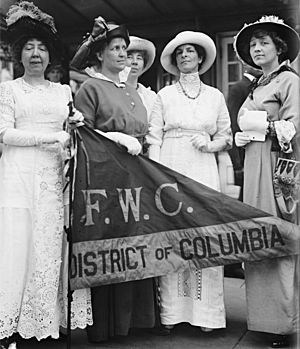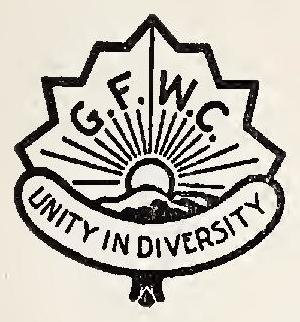General Federation of Women's Clubs facts for kids
 |
|
| Founded | 1890 |
|---|---|
| Headquarters | General Federation of Women's Clubs Headquarters 1734 N Street NW Washington, D.C. |
The General Federation of Women's Clubs (GFWC) is a large group of women's clubs in the United States. It was started in 1890. The GFWC helps communities by doing volunteer work. They have about 60,000 members across the U.S. and in other countries. It is one of the oldest and largest groups of women volunteers in the world. The GFWC headquarters is in Washington, D.C..
Contents
How the GFWC Started
The GFWC was founded by Jane Cunningham Croly. She was a well-known journalist in New York. In 1868, she helped create a club called Sorosis for women who worked professionally. This club became a model for the GFWC.
In 1889, Jane Croly organized a meeting in New York. Delegates from 61 women's clubs came together. In 1890, these women formed a permanent organization. Charlotte Emerson Brown became its first president. In 1901, the U.S. Congress officially recognized the GFWC. Their motto became "unity in diversity," meaning they wanted to be united but also celebrate differences.
At first, local women's clubs joined the GFWC directly. Later, they joined through state groups that started forming in 1892. The GFWC also includes clubs from other countries.
Early Challenges and Growth
In 1900, the GFWC had a meeting in Milwaukee. Josephine Ruffin, a Black journalist, tried to attend. She was representing three clubs from Boston. However, some Southern women, led by president Rebecca Douglas Lowe, said Ruffin could only join as an honorary guest for the two white clubs. They would not allow her to represent a Black club. Ruffin refused this unfair offer. She was then excluded from the meeting. This event was called "The Ruffin Incident." Many newspapers across the country reported on it and supported Ruffin.
At a time when women had limited rights, these state clubs worked hard to make sure women's voices were heard. They held regular meetings where influential women could share their ideas. They met with state officials to discuss community issues. Before women could vote, these clubs were a main way for women to be heard and taken seriously.
After 1890, women's clubs grew very quickly. Many started as reading groups focused on books. But they soon became groups that worked to improve their communities. These clubs were mostly for middle-class women. They met weekly in each other's homes. The clubs usually avoided topics that might cause arguments, like religion or alcohol laws. In some parts of the country, like the South, women's right to vote was also a very dividing topic. However, in the West, many clubwomen supported it. In the Midwest, clubwomen were careful at first, but after 1900, they increasingly supported women's voting rights.
What the GFWC Does
The GFWC played a big part in the Progressive Movement in the United States. During this time, women activists used their roles as mothers and homemakers to get involved in community issues. They saw themselves as "municipal housekeepers." This meant they wanted to "clean up" politics and cities. They also wanted to improve the health and well-being of their neighbors.
These women investigated what their communities needed. They used their "maternal" knowledge to push for changes. They helped create new government programs for social welfare. For example, clubwoman Julia Lathrop led the U.S. Children's Bureau. The GFWC supported many causes. These included safe food and drug laws, healthcare for mothers and children, and stopping child labor. They believed the government should help make society fairer.
Community Projects
In states like Kansas, women's clubs worked with other groups to solve social problems. The clubs continued to discuss books, culture, and current events. But they also started focusing on public schools, local parks, sanitation, and protecting children.
The clubs also strongly supported public libraries. They helped create local libraries and traveling libraries for rural areas. They pushed for state laws to fund and support libraries. GFWC groups worked with library associations and helped create library education programs at universities.
Many clubs were also concerned about the situation of Native Americans. They helped bring John Collier to attention. In 1922, they made him a research agent for their Indian Welfare Committee. The GFWC took a lead role in opposing policies that forced Native Americans to give up their culture. They supported returning Native American lands. They also promoted more religious and economic independence for Native Americans. For example, clubs in the Southwest helped support the Museum of Northern Arizona. They also became supporters of real Native American arts and crafts. In Western states, GFWC groups worked with Collier. He was the Commissioner for Indian Affairs from 1933 to 1945. He worked to change federal policies that tried to make Native Americans fit into the national culture.
In May 1925, Edith Brake West did a survey of county organizations. This survey was recognized by the National Federation of Women's Clubs. It was the first time that the achievements and organization of these groups were clearly shown.
The GFWC had its largest number of members in 1955, with 850,000 members in 16,000 clubs. Since then, the number has gone down to about 70,000 members. This is partly because more middle-class women now work outside the home. During the Cold War, the GFWC promoted the idea that American women could help keep world peace. They also worked to strengthen the nation through local, national, and international community work.
Today, the GFWC's 70,000 members continue to work locally. They support the arts, protect natural resources, improve education, promote healthy living, encourage civic involvement, and work for world peace. In 2009, GFWC members raised over $39 million for more than 110,000 projects. They also volunteered over 4.1 million hours in their communities.
Important Clubwomen
Many notable women have been part of the GFWC, including:
- Jane Cunningham Croly (1829–1901), the founder of GFWC.
- Julia Ward Howe (1819–1910), a famous writer and social activist.
- Julia Lathrop (1858–1932), who led the U.S. Children's Bureau.
- Eleanor Roosevelt (1884–1962), a former First Lady of the United States.
- Margaret Chase Smith (1897–1995), a U.S. Senator.
- Nellie Tayloe Ross (1876–1977), the first female governor in the U.S.
- Zitkala-Sa (1876–1938), also known as Gertrude Simmons Bonnin, a Native American writer and activist who created the Indian Welfare Committee for the GFWC.
See also
- Alabama Federation of Women’s Clubs
- Anchorage Woman's Club
- Casa Grande Woman's Club
- Federation of Women's Clubs for Oklahoma and Indian Territories
- General Federation of Women's Clubs of South Carolina
- Glendale Woman's Club
- Mississippi Federation of Women's Clubs
- National Association of Colored Women's Clubs
- Nineteenth Amendment to the United States Constitution
- Ossoli Circle
- Women's club movement
- Woman's Club of Olympia
- Women's Institute
- Women-only space




